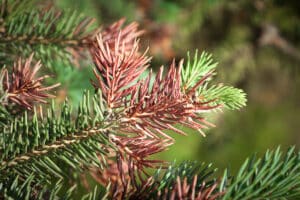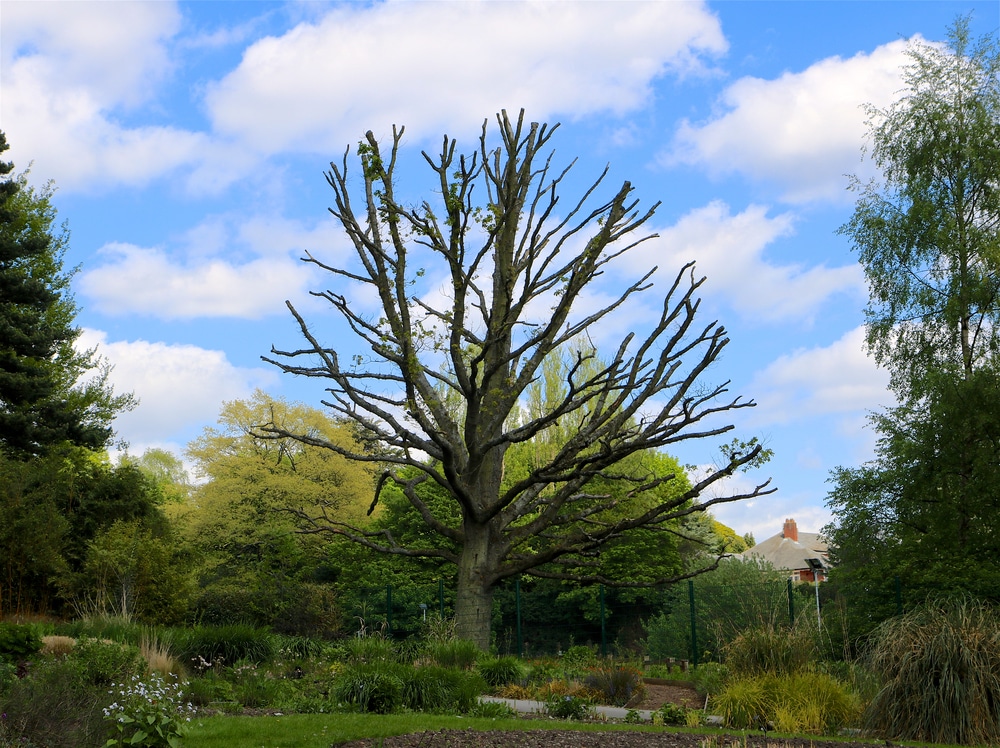No one wants to see a tree on their property show signs of dying, whether suddenly or over time.
Trees are usually very durable, with trunks, roots, and branches that stand up to all sorts of stresses and trauma. However, there are still plenty of tree diseases, environmental causes, and other issues that can cause a tree to die.
Let’s take a closer look at the causes and signs of a tree dying. Then, we’ll focus on preventing those causes and treating damaged and dying trees.
My Tree Looks Like It’s Dying! What Happened?
There are many potential causes of dying trees. The University of Tennessee’s Agricultural Extension Service explains in detail what causes a tree to die. The short story is that dying trees can no longer engage in photosynthesis. Without that process, they can’t create the energy they need to live.
What factors cause a tree to reach this point? There are many possible issues to keep in mind.
Common Causes of Tree Death
Oregon State University’s Extension Service highlighted a few causes of tree death that are regularly seen in the Pacific Northwest:
- Pests and infections: Insects that attack trees can quickly lead to dead branches or a damaged root system. Fungi and other sources of tree disease can cause widespread problems.
- Lack of moisture: Trees need moisture to fuel the processes that protect against disease and other issues. A lack of moisture may be caused by the tree’s location, a high number of other trees in the area, or the soil in which it’s planted. Keep in mind that excessive moisture can also lead to rot and a variety of tree problems.
- High heat: When a tree can’t cool itself effectively due to very high heat, it can suffer stress that weakens its systems. That’s true even if there’s moisture available to the tree.
- Too much competition: Having too many trees in too small of an area can cause them to compete for moisture. Some trees will be left without the resources they need to grow and thrive.
- End of natural lifecycle: Trees have long lifespans, but don’t live indefinitely. They will eventually reach the end of their lifecycle.
Signs Your Tree May Be Dying
With an understanding of what can cause your tree to die, let’s look at some signs that a tree may be in danger or already in the process of dying. We’ve already covered these signs of a dying tree in depth in a dedicated article, so let’s focus on a quick run-down:
- No or little new growth: Trees with fewer buds and leaves, smaller leaves, and less twig growth than normal may be dying. The lack of consistency in growth is a clear sign of a problem.
- Crown dieback: You can identify this problem by looking for signs of dead branches and reduced or no growth at the crown — the top of your tree.
- High levels of insect and animal activity: Keep an eye out for infestations and signs of insects and animals damaging your tree. If you discover this sign, the health of your tree could be very poor.
Root damage: The base of a tree can indicate possible problems. Pay close attention to black (rot) and brown (absorbing toxic chemicals, dehydration) discolorations.

Can You Stop a Tree From Dying?
In some cases, trees will only show major visible signs of an issue when they’re already dead, or close to it. Even the most careful approach to tree care won’t make much of a difference, unfortunately. It’s important to keep your expectations realistic when it comes to a dying tree.
However, there are plenty of things you can do to help your trees. Consider a yearly inspection of your trees to identify potential problems (or call an arborist to take a look for you). It’s easier to catch smaller signs of a disease or infestation when you’re more familiar with your trees.
Ensuring trees aren’t packed too closely together, either with each other or other vegetation, is also an important step. In the long term, it’s much better to have a smaller number of trees thrive. then to have a larger number barely survive.
Work With Professional Certified Arborists
Certified arborists are tree experts. They have the deep knowledge and experience needed to identify specific issues in trees, then select and use the most appropriate treatment.
From simple changes to much more involved efforts to save a dying tree, they can build a plan with the best chance of success.
We are Oregon’s most trusted tree service company. Schedule a free estimate today!
